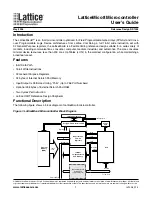
©COMEV
AL
V
AL
VE SYSTEMS
Technical Dept. Ref. IOM - PNEUMA
TIC
ACTUA
TORS
AF SERIES - Ed.20/1
1
Comeval V
alve Systems reserves the right to alter any technical data contained in this Manual without prior notice. Regularly updated data on www
.comeval.es
COLUMNLESS PNEUMATIC ACTUATORS AF SERIES
FOR DIAPHRAGM VALVES
Page 7
Recommended Spare parts
(see parts list in Chapter 13
Use only original spare parts.
It is advisable to keep parts 15 and 8 as spare parts. Type and number of each spare part to be stored according to many
factors: service level, actuators’ quantity, etc. In many cases a good choice is to keep complete actuator as spare part.
8. TROUBLESHOOTING
In the event of malfunction or faulty operating performance, check that the installation and adjustment work has been carried
out and completed in accordance with this Manual.
ATTENTION!
- It is essential that the safety regulations are observed when identifying faults.
9. TROUBLESHOOTING TABLE
ATTENTION!
- Read the complete Manual before carrying out installation and repair work.
- Read chapter 6 before recommissioning
.
FAULT
POSSIBLE CAUSE
CORRECTING MEASURES
Actuator unit
does not
move
Wrong air supply connection
Check correct air supply connection
Connection opposite to air supply connection
(venting) is plugged or blocked, not venting
Discard this
No air supply pressure or too low
Check air supply pressure
Actuator already reached limit position
Check actuator position
Actuator manual device (handwheel) limiting the
operation
Release the manual handwheel to allow
pneumatic operation
Spring broken
Check spring and replace if needed. Refer to
chapter 7
Some part stuck inside the valve
Dismount the valve and check inside. Refer to
chapter 7
Actuator unit
moves too
slowly or not
reaching limit
position
Air supply pressure too low
Recheck air supply pressure on actuator
nameplate. Increase only the needful, without
exceeding max.value
Connection opposite to air supply connection
partially plugged or restricted
Discard this
Significant leakage on air supply line
Correct leakage, retigthen fittings if needed.
Refer to chapter 6
Air supply line restricted, solenoid valve or
positionner obstructed or wrongly adjusted
Check inlet air supply system
Actuator manual device (handwheel) limiting the
operation
Release the manual handwheel to allow
pneumatic operation
Actuator diaphragm not properly assembled (upper
and lower chamber communicated)
Ensure the diaphragm is well clamped in its
raised center to make tightness
Actuator diaphragm damaged (upper and lower
chamber communicated)
Replace diaphragm. Refer to chapter 7
Leakage between upper and lower case
Retighten chambers union bolts or replace
actuator diaphragm. Refer to chapter 6 and 7
Too much pressure on the main line, medium to
viscous or with impurities
Check working parameters
Spring broken
Check spring and replace if needed. Refer to
chapter 7
External
air leakage
through
actuator
Leakage between upper and lower chamber
Retighten chambers union bolts or replace
actuator diaphragm. Refer to chapter 6 and 7
Leakage from upper or lower chamber
Retighten bolts or replace o-rings in bonnet
and/or in spring’s seat. Refer to chapter 6 and 7
Actuator unit
moves too
quickly
Air supply pressure too high
Recheck air supply pressure acc. to actuator
nameplate. Set to the minimum necessary to
operate the valve



























